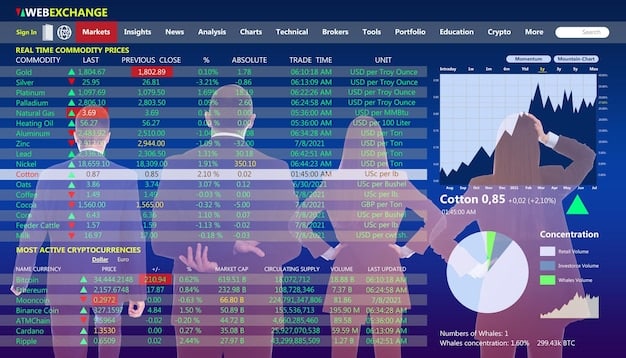Fact-Checking the Projected 3.2% Social Security COLA for 2025

The projected 3.2% Cost-of-Living Adjustment (COLA) for Social Security in 2025 is not a myth but a dynamic estimate based on inflation data, primarily the Consumer Price Index for Urban Wage Earners and Clerical Workers (CPI-W), which aims to adjust benefits to maintain purchasing power for beneficiaries.
In the realm of retirement planning and financial stability, few topics spark as much public interest and speculation as the annual Cost-of-Living Adjustment (COLA) for Social Security. With projections of a 3.2% COLA for 2025 circulating, many beneficiaries and future retirees are asking: is this a reliable figure, or simply a wishful rumor? This article delves into the intricacies of COLA calculations, separates fact from fiction, and provides a clear understanding of what this potential increase could mean for millions of Americans.
Understanding the Social Security COLA: A Historical Perspective
The Cost-of-Living Adjustment (COLA) is an annual increase in Social Security benefits designed to offset the effects of inflation. Its purpose is to ensure that the purchasing power of Social Security benefits doesn’t erode over time due to rising costs of living. This adjustment is crucial for millions of retirees, disabled individuals, and survivors who rely on these benefits for their daily expenses.
The COLA’s history traces back to 1975, following a 1973 law that mandated automatic annual adjustments. Before this, benefit increases required an act of Congress. The shift to automatic adjustments aimed to depoliticize the process and provide a more predictable and timely response to inflation. This change was a significant step toward safeguarding the financial well-being of beneficiaries.
How COLA is Calculated: The Role of CPI-W
The method for calculating the Social Security COLA is specifically defined by law. It relies on the Consumer Price Index for Urban Wage Earners and Clerical Workers (CPI-W), which is published monthly by the Bureau of Labor Statistics (BLS). This index measures the average change over time in the prices paid by urban wage earners and clerical workers for a market basket of consumer goods and services.
- Reference Period: The crucial data points for COLA calculation come from the third quarter (July, August, and September) of the current year.
- Comparison Point: The average CPI-W for this period is compared to the average CPI-W from the third quarter of the most recent year in which a COLA was payable.
- Percentage Change: The percentage difference between these two averages determines the COLA percentage. If there’s no increase in CPI-W, there’s no COLA.
It’s important to recognize that the CPI-W isn’t the only measure of inflation, nor is it universally seen as the most accurate reflection of costs for seniors. For instance, the Consumer Price Index for All Urban Consumers (CPI-U) is another commonly cited inflation metric, but by law, CPI-W is the determinant for COLA.
The reliance on CPI-W has drawn criticism, with some arguing that it doesn’t adequately reflect the unique spending patterns of seniors, who often allocate a larger portion of their income to healthcare costs, which tend to rise faster than general inflation. Discussions about adopting an experimental Consumer Price Index for the Elderly (CPI-E) have occurred, but no legislative change has been made to incorporate it into COLA calculations.
Understanding this methodology is key to appreciating why COLA projections, while often accurate, are never truly final until the official announcement in October. The fluctuating nature of economic data, particularly within the specified third-quarter window, means that initial estimates can, and often do, shift. This dynamic ensures that the adjustment reflects the most current inflationary pressures experienced by working-class Americans.
Decoding the 3.2% Projection: Sources and Reliability
The projection of a 3.2% COLA for 2025 has become a significant talking point, raising both hopes and questions among Social Security beneficiaries. While it’s natural to be enthusiastic about a potential increase, it’s equally important to understand where these numbers originate and how reliable they are at this stage.
These early COLA projections typically come from various reputable organizations and individuals who closely monitor economic indicators. These include:
- The Bipartisan Policy Center (BPC): Known for its detailed analysis of Social Security and other federal programs, the BPC often releases early COLA projections based on its economic modeling.
- The Senior Citizens League (TSCL): This advocacy group for seniors frequently publishes COLA estimates, often to highlight the financial challenges faced by retirees due to inflation.
- Independent Economists and Analysts: Many private economists and financial firms generate their own COLA forecasts, using their expertise in macroeconomic trends and inflation data.
These organizations and individuals leverage publicly available data, primarily from the Bureau of Labor Statistics (BLS), specifically the Consumer Price Index for Urban Wage Earners and Clerical Workers (CPI-W). They use the same formula that the Social Security Administration (SSA) will eventually use, but they do so proactively, before all the necessary data points are officially released.
Are Early Projections Set in Stone?
The short answer is no, early projections are not set in stone. They are educated estimates based on the available economic data at the time of their release. Here’s why these numbers can change:
- Dynamic Nature of CPI-W: The COLA calculation relies on the average CPI-W from July, August, and September. While projections might be made earlier in the year, the actual numbers for these critical months are still unknown. Any significant shifts in inflation during this period can alter the final COLA percentage.
- Economic Volatility: Unforeseen economic events, such as changes in energy prices, supply chain disruptions, or shifts in consumer demand, can impact inflation rates quickly. These factors can cause the CPI-W to fluctuate, leading to adjustments in the projected COLA.
- Data Revisions: Although less common for CPI data, economic statistics can sometimes undergo revisions, which could marginally affect projections.
Therefore, while a 3.2% projection offers a valuable glimpse into what beneficiaries might expect, it should be viewed as a strong possibility rather than a definitive figure. The official announcement from the Social Security Administration (SSA) typically occurs in October, after all the necessary third-quarter CPI-W data has been collected and analyzed. Until then, beneficiaries should keep in mind that the number reflects current economic trends and projections, which are always subject to change.
The Impact of Inflation: Why COLA Matters
Inflation is an economic phenomenon that directly impacts the purchasing power of money. When prices for goods and services rise, each dollar buys less than it did before. For individuals living on fixed incomes, such as Social Security beneficiaries, inflation can be particularly debilitating. This is where the Cost-of-Living Adjustment (COLA) becomes critically important.
Without regular COLA increases, the real value of Social Security benefits would steadily decline over time. Imagine this: a benefit check that covered all your essential expenses a decade ago might only cover half of them today if prices had doubled and your benefit remained unchanged. COLA aims to prevent this erosion, allowing beneficiaries to maintain a relatively stable standard of living despite rising costs.
Specific Costs Affecting Seniors
While inflation affects everyone, certain cost categories tend to disproportionately impact seniors. These include:
- Healthcare: Medical expenses, including prescription drugs, doctor visits, and insurance premiums, often rise faster than general inflation. Seniors typically have higher healthcare needs, making them particularly vulnerable to these increases.
- Housing: Rent, property taxes, and home maintenance costs can consume a significant portion of a senior’s budget. Rising housing costs in many areas present a considerable challenge.
- Utilities: Electricity, gas, and water bills are essential expenses that can fluctuate, putting pressure on fixed incomes.
- Food: The cost of groceries is a fundamental expense that directly impacts daily living. Food price volatility can quickly strain a tight budget.
These specific cost pressures highlight why the COLA is not just a statistical adjustment but a vital component of financial security for millions. Even a seemingly small percentage increase can make a substantial difference in a beneficiary’s ability to afford necessities.

The effectiveness of COLA in fully offsetting these specific cost increases is a subject of ongoing debate. Critics argue that the CPI-W, which includes a broad basket of goods and services, doesn’t accurately capture the spending habits of seniors, who typically spend more on healthcare and less on categories like transportation or education. This discrepancy can lead to a perception that the COLA, while helpful, doesn’t always keep pace with the true inflation experienced by older Americans.
Ultimately, while the COLA mechanism strives to protect beneficiaries from the long-term effects of inflation, its real-world impact is continually assessed against the backdrop of rising prices in critical sectors. These discussions underscore the complex relationship between economic indicators and the daily financial realities of Social Security recipients.
Fact vs. Fiction: Debunking COLA Myths
In the lead-up to the annual COLA announcement, numerous myths and misconceptions often circulate, leading to confusion and unnecessary concern among beneficiaries. Separating fact from fiction is crucial for understanding what to realistically expect from the Social Security increase.
One common myth is that the COLA is a discretionary bonus or a political handout. In reality, the COLA is mandated by law and calculated using a specific, transparent formula tied to the Consumer Price Index for Urban Wage Earners and Clerical Workers (CPI-W). It’s designed to be an automatic adjustment, not a decision made by politicians trying to gain favor.
Misconceptions about Social Security Fund Solvency
Another prevalent myth links COLA directly to the solvency of the Social Security trust funds. Some believe that a large COLA will deplete the funds faster, or that a small COLA indicates the system is on the brink of collapse. While the health of the Social Security trust funds is indeed a serious long-term concern, the annual COLA has a relatively minor and indirect impact on its overall solvency.
- Independent Calculation: COLA is calculated based on inflation, not on the financial health of the Social Security system.
- Long-Term Projections: Solvency issues are driven by broader demographic trends (e.g., lower birth rates, increased longevity) and economic factors, not annual benefit adjustments designed to maintain purchasing power.
- Legislative Solutions: Addressing long-term solvency requires significant legislative action, such as adjusting the retirement age, modifying benefit formulas, or increasing revenue, rather than manipulating the COLA.
The annual Trustees’ Report on the Social Security and Medicare trust funds provides a comprehensive assessment of the system’s financial outlook, which is a more reliable source for understanding solvency issues than COLA projections. It’s important to differentiate between the mechanism for adjusting benefits to inflation and the larger, more complex challenges facing the Social Security system’s long-term financial stability.
COLA and Medicare Premiums
A significant area of confusion arises when discussing COLA in relation to Medicare Part B premiums. It is a common misconception that a COLA increase will automatically lead to a net increase in a beneficiary’s take-home Social Security payment. This isn’t always the case.
Medicare Part B premiums are often deducted directly from Social Security benefits. When the Part B premium increases, it can offset some or even all of the COLA increase, especially for lower-income beneficiaries. This phenomenon is known as the “hold harmless” provision, which prevents Part B premiums from reducing a beneficiary’s net Social Security payment from one year to the next, provided they receive Social Security benefits directly.
However, this provision has complexities, and for those not covered by “hold harmless” (e.g., new enrollees, those paying higher income-related monthly adjustment amounts (IRMAA) for Medicare Part B and Part D), an increase in the Medicare premium can indeed significantly diminish the real value of their COLA.
Understanding these distinctions is essential for beneficiaries to accurately plan their finances. The COLA is a measure to preserve purchasing power, but other factors, particularly rising healthcare costs, can influence the final amount that appears in a Social Security check.
Preparing for the 2025 COLA: What Beneficiaries Should Do
While the official 2025 COLA announcement is yet to come, the projected 3.2% increase provides a valuable opportunity for Social Security beneficiaries to plan ahead. Proactive financial management can help ensure that any increase effectively supports your financial well-being.
The immediate impact of a COLA is on the monthly benefit amount. Knowing the projection allows beneficiaries to adjust their personal budgets. If the 3.2% projection holds, it means every $1,000 of benefits would increase by $32. For many, this could translate into a few extra dollars that, while seemingly small, can make a significant difference in covering essential expenses or building a small savings buffer.
Budgeting with a Projected Increase
Even though the number isn’t final, incorporating a projected COLA into your preliminary budget can be a wise move. This doesn’t mean spending it before you receive it, but rather using the estimate to re-evaluate your income and expenses for the upcoming year.
Consider the following steps:
- Re-evaluate Expenses: Look at your current spending habits. Have any costs increased significantly? Are there areas where you can trim expenses?
- Anticipate Medicare Changes: Remember that Medicare Part B premiums are also subject to annual adjustments. While the COLA aims to offset inflation, a rise in Medicare premiums might absorb some of the Social Security increase. Projections for Medicare premiums are typically released later in the year, often around the same time as the COLA.
- Factor in Taxes: A higher Social Security benefit might impact your taxable income. While many Social Security beneficiaries do not pay federal income tax on their benefits, some do, depending on their “provisional income.” A COLA could potentially push some individuals into a higher tax bracket or increase the portion of their benefits subject to taxation.
It’s advisable to revisit your overall financial plan, accounting for both potential benefit increases and any anticipated cost hikes. This holistic approach ensures that any COLA truly contributes to your financial stability.
Official Announcement and What to Look For
The official COLA announcement typically happens in October, coinciding with the release of the final third-quarter CPI-W data. When the announcement is made, it’s crucial to look for:
- The Exact Percentage: The final, official COLA percentage for 2025.
- Average Benefit Increase: The Social Security Administration (SSA) usually provides an estimate of the average dollar increase for different types of beneficiaries (e.g., retired workers, couples).
- Medicare Premium Update: Information about any changes to Medicare Part B premiums, as these will directly impact the net benefit received.
The SSA will send out notices to beneficiaries in December detailing their new benefit amount for January of the following year. This notice is the definitive source for your personal COLA adjustment. While external projections offer valuable insights, the official SSA communication is the one beneficiaries should rely upon for their specific financial planning.
Beyond the Numbers: The Broader Economic Context
While the 3.2% COLA projection for 2025 is a critical number for Social Security beneficiaries, it’s essential to view it within the broader economic context. The COLA is a lagging indicator; it reflects past inflation, not future economic conditions. Therefore, understanding the current economic climate helps in assessing the appropriateness and impact of any COLA increase.
Several economic factors influence inflation and, consequently, the COLA. These include:
- Energy Prices: Fluctuations in oil and gas prices directly impact transportation costs and utility bills, which feed into the CPI-W.
- Supply Chain Dynamics: Disruptions or improvements in global supply chains can affect the availability and cost of goods, influencing overall prices.
- Consumer Demand: Strong consumer demand, driven by factors like employment rates and wage growth, can also push prices higher.
- Monetary Policy: Actions by the Federal Reserve, such as interest rate adjustments, aim to influence inflation, which can indirectly affect future COLA considerations.
The economic landscape in the period leading up to the 2025 COLA decision would have been characterized by efforts to moderate inflation. Central banks worldwide have been navigating the complexities of post-pandemic economic recovery, balancing growth with price stability. If inflation appears to be cooling, future COLA projections might trend lower. Conversely, persistent inflationary pressures could lead to larger adjustments.

It’s also worth noting the ongoing discussions about the long-term sustainability of Social Security. While COLA addresses the immediate purchasing power of benefits, the larger debate revolves around how to ensure the program remains solvent for future generations. These discussions often involve considerations of demographics, life expectancy, and potential reforms to the system.
The COLA, while directly linked to inflation, also plays a role in broader economic stability. It provides a measure of predictability for millions of households, enabling them to better manage their finances. An accurate and timely adjustment helps prevent a significant segment of the population from experiencing undue financial hardship during periods of rising costs, thus contributing to overall economic resilience.
The dialogue surrounding Social Security’s long-term health, coupled with the annual COLA calculation, underscores the interconnectedness of individual financial well-being and national economic policy.
Conclusion
| Key Point | Brief Description |
|---|---|
| 📊 COLA Projection | The 3.2% COLA for 2025 is a strong estimate, not yet final. |
| 📉 CPI-W Driven | COLA is calculated based on the Consumer Price Index for Urban Wage Earners and Clerical Workers (CPI-W). |
| 🛡️ Protects Purchasing Power | COLA aims to help benefits keep pace with inflation, especially for seniors. |
| 💡 Plan Accordingly | Use projections for budgeting, but await the official October announcement. |
Frequently Asked Questions
The projected Cost-of-Living Adjustment (COLA) for Social Security in 2025 is currently estimated at 3.2%. This figure is based on economic forecasts and inflation data, primarily from the Consumer Price Index for Urban Wage Earners and Clerical Workers (CPI-W), but it remains subject to change until the official announcement.
The Social Security COLA is calculated by comparing the average Consumer Price Index for Urban Wage Earners and Clerical Workers (CPI-W) from the third quarter (July, August, September) of the current year to the average CPI-W of the third quarter of the most recent year a COLA was paid. The percentage increase is then applied.
The official Social Security COLA for the upcoming year is typically announced by the Social Security Administration (SSA) in mid-October. This timing allows for the collection and analysis of all necessary inflation data from the third quarter (July, August, and September) of the current year.
Yes, increases in Medicare Part B premiums can potentially offset a portion or even all of your Social Security COLA increase, especially for beneficiaries whose premiums are deducted directly from their benefits. While the “hold harmless” provision often protects many, it doesn’t apply to all situations, such as those paying higher income-related premiums.
The COLA is crucial for Social Security beneficiaries because it helps maintain the purchasing power of their benefits in the face of inflation. Without these annual adjustments, the value of their fixed income would erode over time, making it harder to afford essential goods and services like food, housing, and healthcare.
Conclusion
The discussion surrounding the projected 3.2% Social Security COLA for 2025 highlights the critical role of these annual adjustments in maintaining the financial well-being of millions of Americans. It serves as a reminder that while projections offer valuable insights, the final figure is meticulously determined by specific economic data, primarily the CPI-W. Beneficiaries are encouraged to stay informed through official channels, plan their finances proactively, and understand the nuances of how COLA interacts with other financial factors like Medicare premiums. Ultimately, the COLA is not a myth but a vital and dynamic mechanism designed to help ensure that Social Security benefits continue to provide a stable foundation for those who rely on them.





